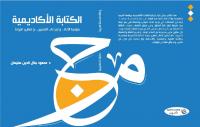Dynamic Assessment of Students’ Academic Writing: Vygotskian and Systemic Functional Linguistic Perspectives 9783030558444
This book explores the application of an innovative assessment approach known as Dynamic Assessment (DA) to academic wri
276 53 6MB
English Pages 274 [260] Year 2020
Table of contents :
Preface
Contents
About the Author
Abbreviations
List of Figures
List of Tables
1 Higher Education, Academic Writing Assessment and Formative Feedback
1.1 Introduction
1.2 Why This Book on Academic Writing Assessment?
1.3 Organisation of the Book
1.4 Higher Education and Academic Writing
1.4.1 Broad Landscape of Learning and Academic Writing in Higher Education
1.4.2 Academic Literacy and Disciplinary Knowledge Construction in Higher Education
1.5 Academic Writing Assessment in Higher Education
1.6 Types of Academic Writing Assessment
1.7 Formative Academic Writing Assessment
1.7.1 Formative Feedback and Academic Writing Assessment
1.7.2 Diagnostic Academic Writing Assessment
1.7.3 Dynamic Assessment (DA) as an Alternative
1.8 Summary
References
2 Sociocultural Theory, Dynamic Assessment and Academic Writing
2.1 Introduction
2.2 Vygotskian Sociocultural Theory
2.2.1 The Genetic Method
2.2.2 Four Domains of the Genetic Method
2.3 Academic Writing as a Semiotically Mediated Social Action in Context
2.4 What Is Dynamic Assessment?
2.5 Key Concepts of Sociocultural Theory and Dynamic Assessment
2.5.1 Zone of Proximal Development
2.5.2 Mediation
2.5.3 Imitation
2.5.4 Internalisation
2.6 Types of Dynamic Assessment
2.6.1 Interventionist Dynamic Assessment Approaches
2.6.2 Interactionist Dynamic Assessment Approaches
2.7 Dynamic Assessment and Other Assessment Approaches
2.8 A Critical Review of Dynamic Assessment
2.9 Summary
References
3 Systemic Functional Linguistics, Dynamic Assessment and Academic Writing
3.1 Introduction
3.2 Systemic Functional Linguistics: A Theory of Language
3.3 Rationale for Using SFL in DA
3.4 Register Variables: Field, Tenor and Mode
3.4.1 Ideational Metafunction
3.4.2 Interpersonal Metafunction
3.4.3 Textual Metafunction
3.5 SFL and Academic Writing
3.6 SFL-Based Genre Theory (and Pedagogy)
3.7 Case Study Analysis as a Key Genre in Business Studies
3.8 Application of SFL in This Book
3.8.1 SFL as an Analytical Tool
3.8.2 SFL as a Pedagogical Tool in Research
3.9 Summary
References
4 Application of Dynamic Assessment to Distance Education
4.1 Introduction
4.2 Context of Academic Writing Assessment: Open and Distance Education
4.3 Nature of Business Studies Assignments
4.4 Design of Research on Dynamic Assessment of Academic Writing
4.4.1 Key Concepts Underpinning the Research Design
4.4.2 Specific Research Context
4.4.3 Participants in My Research
4.5 Conducting Dynamic Assessment of Academic Writing in Distance Education
4.5.1 Existing Dynamic Assessment Procedures
4.5.2 DA Sessions and the Intervention
4.5.3 Non-dynamic Assessment
4.5.4 Transfer Assessment Tasks
4.5.5 Learner Interviews
4.5.6 Subject Specialists’ Views
4.6 Data Analysis in Dynamic Assessment of Academic Writing
4.6.1 Thematic Analysis of Mediation Data
4.6.2 SFL-Based Textual Analysis of DA and Non-DA Texts
4.6.3 Thematic Analysis of the Student Interviews and Business Studies Teachers’ Views
4.7 Summary
References
5 Teacher Mediation, Learner Reciprocity and Academic Writing Development
5.1 Introduction
5.2 Mediation and Its Purpose in Dynamic Assessment
5.3 The Mediation Data Used in This Book
5.4 Analysing Mediational Data
5.5 Issues in Mediation Data Analysis
5.6 Mediational Moves in Dynamic Assessment of Business Academic Writing
5.6.1 Descriptions of Mediational Moves in Dynamic Assessment of Academic Writing
5.6.2 Dynamicity of Mediational Moves
5.6.3 Academic Writing Support in the ZPD
5.7 Learner Reciprocity: Insights into Academic Writing Development of Distance Learners
5.7.1 Analysing Learner Reciprocity in Dynamic Assessment of Academic Writing
5.7.2 Descriptions of Learner Reciprocal Moves in Dynamic Assessment of Academic Writing
5.7.3 Reciprocal Moves and Academic Writing Development
5.8 Summary
References
6 Tracking Learners’ Academic Writing and Conceptual Development Through Systemic Functional Linguistics
6.1 Introduction
6.2 Student Written Text Data Used in This Book
6.3 Analysing Academic Writing Assessment Texts Using an SFL-Based Genre Approach
6.4 What Is Expected of Students in a Case Study Analysis Genre?
6.5 Tracking DA and Non-DA Students’ Academic Writing Performance Through SFL
6.5.1 Identifying Genres in Students’ Assignment Texts
6.5.2 Tracking macroThemes in Students’ Academic Writing
6.5.3 Tracking hyperThemes in Students’ Academic Writing
6.5.4 Case Studies: A Detailed Look at Three Students’ Academic Writing Development
6.5.5 Conceptual Development
6.6 Summary of SFL-Based Examination of Students’ Ability to Write a Case Study Analysis Genre
6.7 Summary
References
7 Transfer of Aspects of Academic Writing to Similar and New Contexts Through Dynamic Assessment
7.1 Introduction
7.2 Dynamic Assessment and Transfer
7.3 Learning Transfer Data Used
7.4 Analysing Transfer Data
7.5 Tracking Learning Transfer in DA Students’ Academic Writing Through SFL
7.5.1 Near Transfer of Academic Writing
7.5.2 Far Transfer of Academic Writing
7.5.3 Learner Perspectives on Dynamic Assessment
7.6 Summary
References
8 Dynamic Assessment of Academic Writing and Its Future in Higher Education
8.1 Introduction
8.2 Why Dynamic Assessment for Academic Writing Assessment?
8.3 Implications for Academic Writing Practitioners
8.3.1 Implicit to Explicit Mediation
8.3.2 Dialogic Feedback
8.3.3 Interpersonal Relationship with Learners
8.4 Implications for Academic Writing Researchers
8.5 Challenges in Conducting Dynamic Assessment
8.5.1 Expertise of the DA Practitioner
8.5.2 Time Constraints
8.5.3 Difficulty on Large-Scale
8.5.4 Choice of Semiotic Mediation Tools
8.5.5 Labour-Intensiveness
8.6 Future Directions for Dynamic Assessment of Academic Writing
8.6.1 Group DA
8.6.2 Computer-Based DA
8.6.3 Online Synchronous Communication for Mediation
8.6.4 Interpersonal Aspects of Mediation and Dialogic Feedback
References
Preface
Contents
About the Author
Abbreviations
List of Figures
List of Tables
1 Higher Education, Academic Writing Assessment and Formative Feedback
1.1 Introduction
1.2 Why This Book on Academic Writing Assessment?
1.3 Organisation of the Book
1.4 Higher Education and Academic Writing
1.4.1 Broad Landscape of Learning and Academic Writing in Higher Education
1.4.2 Academic Literacy and Disciplinary Knowledge Construction in Higher Education
1.5 Academic Writing Assessment in Higher Education
1.6 Types of Academic Writing Assessment
1.7 Formative Academic Writing Assessment
1.7.1 Formative Feedback and Academic Writing Assessment
1.7.2 Diagnostic Academic Writing Assessment
1.7.3 Dynamic Assessment (DA) as an Alternative
1.8 Summary
References
2 Sociocultural Theory, Dynamic Assessment and Academic Writing
2.1 Introduction
2.2 Vygotskian Sociocultural Theory
2.2.1 The Genetic Method
2.2.2 Four Domains of the Genetic Method
2.3 Academic Writing as a Semiotically Mediated Social Action in Context
2.4 What Is Dynamic Assessment?
2.5 Key Concepts of Sociocultural Theory and Dynamic Assessment
2.5.1 Zone of Proximal Development
2.5.2 Mediation
2.5.3 Imitation
2.5.4 Internalisation
2.6 Types of Dynamic Assessment
2.6.1 Interventionist Dynamic Assessment Approaches
2.6.2 Interactionist Dynamic Assessment Approaches
2.7 Dynamic Assessment and Other Assessment Approaches
2.8 A Critical Review of Dynamic Assessment
2.9 Summary
References
3 Systemic Functional Linguistics, Dynamic Assessment and Academic Writing
3.1 Introduction
3.2 Systemic Functional Linguistics: A Theory of Language
3.3 Rationale for Using SFL in DA
3.4 Register Variables: Field, Tenor and Mode
3.4.1 Ideational Metafunction
3.4.2 Interpersonal Metafunction
3.4.3 Textual Metafunction
3.5 SFL and Academic Writing
3.6 SFL-Based Genre Theory (and Pedagogy)
3.7 Case Study Analysis as a Key Genre in Business Studies
3.8 Application of SFL in This Book
3.8.1 SFL as an Analytical Tool
3.8.2 SFL as a Pedagogical Tool in Research
3.9 Summary
References
4 Application of Dynamic Assessment to Distance Education
4.1 Introduction
4.2 Context of Academic Writing Assessment: Open and Distance Education
4.3 Nature of Business Studies Assignments
4.4 Design of Research on Dynamic Assessment of Academic Writing
4.4.1 Key Concepts Underpinning the Research Design
4.4.2 Specific Research Context
4.4.3 Participants in My Research
4.5 Conducting Dynamic Assessment of Academic Writing in Distance Education
4.5.1 Existing Dynamic Assessment Procedures
4.5.2 DA Sessions and the Intervention
4.5.3 Non-dynamic Assessment
4.5.4 Transfer Assessment Tasks
4.5.5 Learner Interviews
4.5.6 Subject Specialists’ Views
4.6 Data Analysis in Dynamic Assessment of Academic Writing
4.6.1 Thematic Analysis of Mediation Data
4.6.2 SFL-Based Textual Analysis of DA and Non-DA Texts
4.6.3 Thematic Analysis of the Student Interviews and Business Studies Teachers’ Views
4.7 Summary
References
5 Teacher Mediation, Learner Reciprocity and Academic Writing Development
5.1 Introduction
5.2 Mediation and Its Purpose in Dynamic Assessment
5.3 The Mediation Data Used in This Book
5.4 Analysing Mediational Data
5.5 Issues in Mediation Data Analysis
5.6 Mediational Moves in Dynamic Assessment of Business Academic Writing
5.6.1 Descriptions of Mediational Moves in Dynamic Assessment of Academic Writing
5.6.2 Dynamicity of Mediational Moves
5.6.3 Academic Writing Support in the ZPD
5.7 Learner Reciprocity: Insights into Academic Writing Development of Distance Learners
5.7.1 Analysing Learner Reciprocity in Dynamic Assessment of Academic Writing
5.7.2 Descriptions of Learner Reciprocal Moves in Dynamic Assessment of Academic Writing
5.7.3 Reciprocal Moves and Academic Writing Development
5.8 Summary
References
6 Tracking Learners’ Academic Writing and Conceptual Development Through Systemic Functional Linguistics
6.1 Introduction
6.2 Student Written Text Data Used in This Book
6.3 Analysing Academic Writing Assessment Texts Using an SFL-Based Genre Approach
6.4 What Is Expected of Students in a Case Study Analysis Genre?
6.5 Tracking DA and Non-DA Students’ Academic Writing Performance Through SFL
6.5.1 Identifying Genres in Students’ Assignment Texts
6.5.2 Tracking macroThemes in Students’ Academic Writing
6.5.3 Tracking hyperThemes in Students’ Academic Writing
6.5.4 Case Studies: A Detailed Look at Three Students’ Academic Writing Development
6.5.5 Conceptual Development
6.6 Summary of SFL-Based Examination of Students’ Ability to Write a Case Study Analysis Genre
6.7 Summary
References
7 Transfer of Aspects of Academic Writing to Similar and New Contexts Through Dynamic Assessment
7.1 Introduction
7.2 Dynamic Assessment and Transfer
7.3 Learning Transfer Data Used
7.4 Analysing Transfer Data
7.5 Tracking Learning Transfer in DA Students’ Academic Writing Through SFL
7.5.1 Near Transfer of Academic Writing
7.5.2 Far Transfer of Academic Writing
7.5.3 Learner Perspectives on Dynamic Assessment
7.6 Summary
References
8 Dynamic Assessment of Academic Writing and Its Future in Higher Education
8.1 Introduction
8.2 Why Dynamic Assessment for Academic Writing Assessment?
8.3 Implications for Academic Writing Practitioners
8.3.1 Implicit to Explicit Mediation
8.3.2 Dialogic Feedback
8.3.3 Interpersonal Relationship with Learners
8.4 Implications for Academic Writing Researchers
8.5 Challenges in Conducting Dynamic Assessment
8.5.1 Expertise of the DA Practitioner
8.5.2 Time Constraints
8.5.3 Difficulty on Large-Scale
8.5.4 Choice of Semiotic Mediation Tools
8.5.5 Labour-Intensiveness
8.6 Future Directions for Dynamic Assessment of Academic Writing
8.6.1 Group DA
8.6.2 Computer-Based DA
8.6.3 Online Synchronous Communication for Mediation
8.6.4 Interpersonal Aspects of Mediation and Dialogic Feedback
References

![Dynamic Assessment of Students’ Academic Writing: Vygotskian and Systemic Functional Linguistic Perspectives [1st ed.]
9783030558444, 9783030558451](https://ebin.pub/img/200x200/dynamic-assessment-of-students-academic-writing-vygotskian-and-systemic-functional-linguistic-perspectives-1st-ed-9783030558444-9783030558451.jpg)

![Writing as Meaning-Making: A Systemic Functional Linguistic Approach to EFL Writing [1st ed. 2022]
9789811903199, 9789811903205, 9811903190](https://ebin.pub/img/200x200/writing-as-meaning-making-a-systemic-functional-linguistic-approach-to-efl-writing-1st-ed-2022-9789811903199-9789811903205-9811903190.jpg)




![Academic Writing for University Students [1 ed.]
0367445387, 9780367445386](https://ebin.pub/img/200x200/academic-writing-for-university-students-1nbsped-0367445387-9780367445386.jpg)

